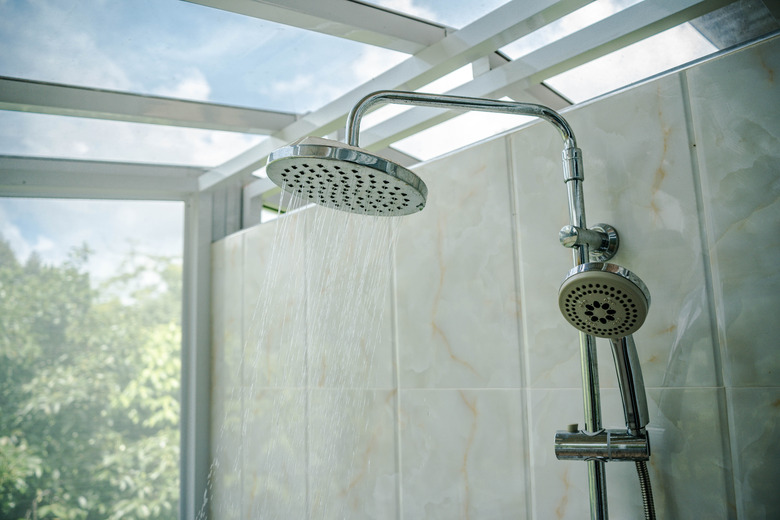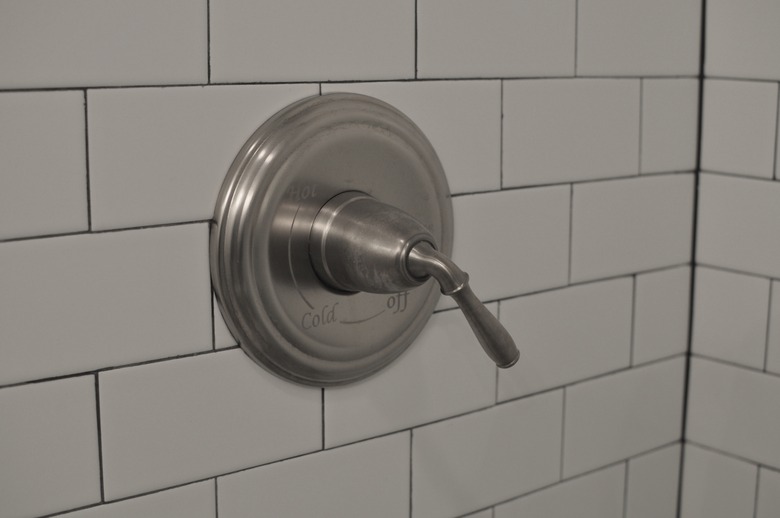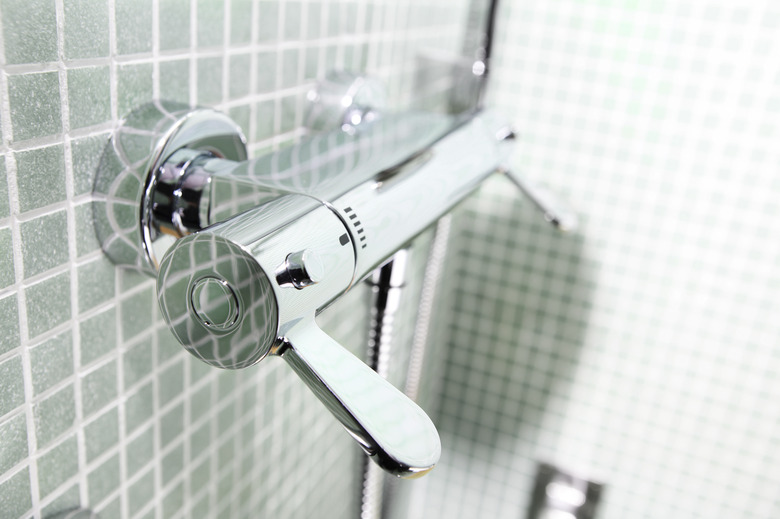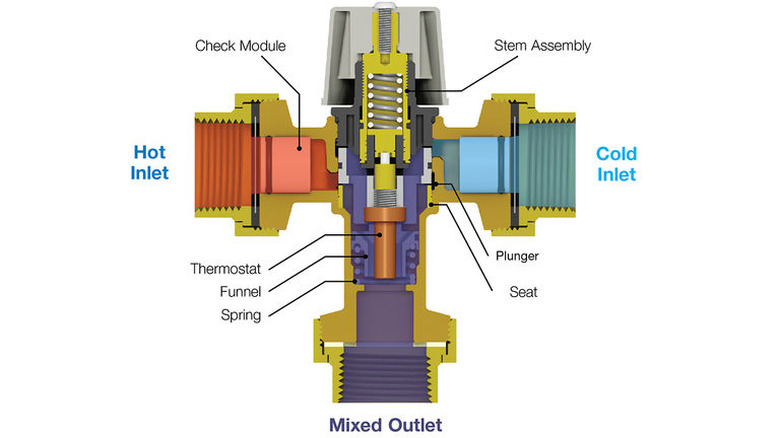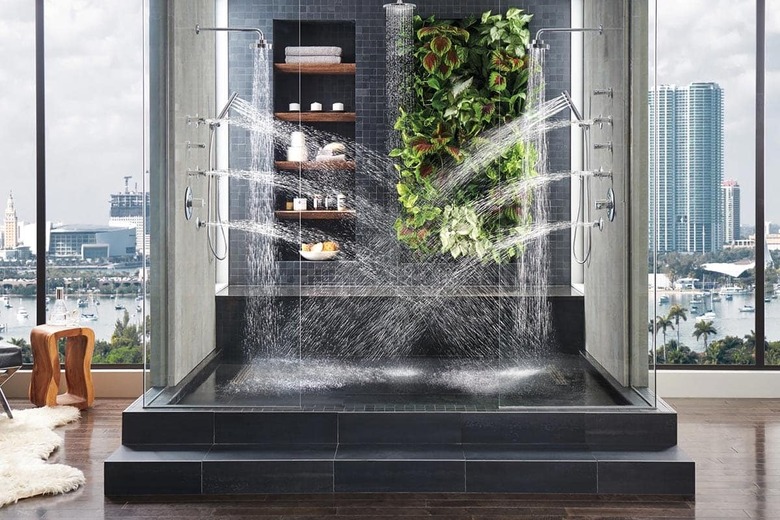What Is A Pressure-Balance Shower Valve?
If you live in an older house with less-than-perfect plumbing, you're no doubt aware of the reason why pressure-balance shower valves are so widely available. You've probably had more than one shower interrupted by a sudden surge of cold or hot water precipitated by someone flushing a toilet, turning on the hot water in the kitchen or starting the washing machine.
The problem is that, when any other fixture calls for hot or cold water, less is available at the shower. You could address this situation by re-doing your plumbing with bigger pipes so changes in water demand wouldn't be as noticeable, but that's an expensive and, in most cases, impractical solution. A more realistic industry option is to devise a shower valve that can compensate for changes in water pressure. Faucet manufacturers have your back (and the rest of your body), because that's exactly what they did.
Pressure-balance shower valves aren't the only temperature-compensating faucets on the market. Thermostatic shower valves work a little differently, and in many ways, they are superior, but they are also more expensive.
A Pressure-Balance Valve Monitors and Regulates Water Pressure
A Pressure-Balance Valve Monitors and Regulates Water Pressure
A pressure-balance valve is basically a standard single-handle mixing valve with one important addition: a pressure-sensitive piston, spool or diaphragm. When the hot water pressure increases relative to the cold pressure, it moves in one direction to limit hot water flow while at the same time increasing the flow of cold water. When the cold water pressure increases, it moves in the opposite direction to limit the flow of cold water and increase the flow of hot water. The ultimate result, in either case, is that the water temperature stays the same.
One of the drawbacks of a pressure-balance valve is that you can't control water temperature and flow rate at the same time. Consequently, if the hot or cold pressure suddenly decrease, the flow rate also goes down. A drastic decrease in pressure can reduce the shower flow to a trickle. Another drawback is that scale and debris in the water, such as rust, can force the pressure valve to stick, resulting in the loss of the pressure-compensating feature altogether.
A Thermostatic Valve Is a Higher-Quality Shower Alternative
A Thermostatic Valve Is a Higher-Quality Shower Alternative
A thermostatic shower valve monitors the temperature of the water in much the same way that the thermostat in a car radiator does. Instead of a pressure-sensitive piston, it has a temperature sensitive element that expands and contracts when the water temperature changes. When the water temperature exceeds the temperature setting, the element expands to allow in more cold water and maintain the output at the selected temperature.
This type of valve can maintain the same temperature independent of flow rate, so the handle has one dial that sets the temperature and another that controls the flow rate. Once you've set the temperature, it will remain constant until you reset it, so all you have to do is turn the water on and off and adjust the flow rate. The flow might decrease when someone else in the house turns on a faucet, but the temperature will stay the same, and you simply have to increase the flow rate to compensate.
Tip
Typical water heater temperatures are around 140 degrees F, so both pressure balancing and thermostatic valves have adjustable temperature limiters. Once you set the limiter, it prevents you from turning the control handle any farther to the hot side. A safe maximum temperature is in a range from 110 to 120 degrees Fahrenheit.
Pressure-Balance Valves Prevent Scalds and Thermal Shock
Pressure-Balance Valves Prevent Scalds and Thermal Shock
A sudden change in temperature during a shower is not just uncomfortable, it can be a hazard. A surge of hot water can cause scalding, and the thermal shock caused by the temperature change could make someone slip and lose their balance. An elderly or handicapped person who slips and falls could be seriously injured.
To prevent scalding, some homeowners turn the temperature of the water heater down to around 120 degrees F, which also saves energy. This isn't a good idea, because certain harmful bacteria, such as legionella (which causes Legionnaire's Disease) can thrive at this temperature. They can't survive at 140 degrees F, which is the minimum recommended temperature.
Should You Choose a Pressure-Balance or a Thermostatic Valve?
Should You Choose a Pressure-Balance or a Thermostatic Valve?
If you're considering a new shower valve, and budget is your main concern, you'll probably want to focus pressure-balance valves. They range from $80 to around $300, whereas thermostatic valves start at around $250, although you can find less expensive ones if you look hard enough.
For the money, a thermostatic valve is usually a better buy. It has three advantages over pressure-balance valves:
- Temperature is easily adjustable: You can set the best temperature for your shower and leave it that way. There's no need to risk getting getting scalded when the first blast of hot water finally makes it through the pipes to the shower head.
- Adaptable for large showers: A single thermostatic valve can service a large shower with more than one shower head. You can use the handheld shower head at the same time as the overhead one, and the temperature from both will be the same.
- Saves water: Because the temperature and volume controls are separate, you can shower at a lower flow rate and still get comfortably hot water. Also, you won't waste water while fiddling with the control to get the perfect temperature.
When it comes to installation or replacement, the procedure for a pressure balance valve is the same as that for a thermostatic valve. No extra work is required for either, so the plumbing costs are the same.
